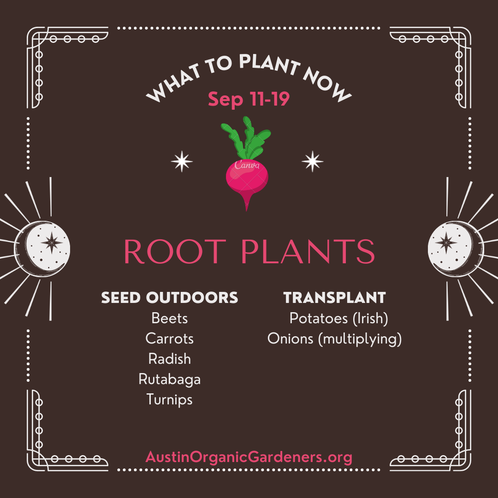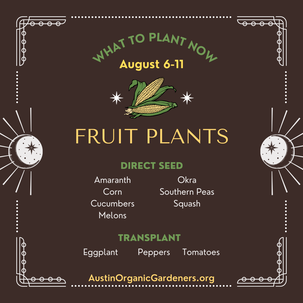 We hope you enjoyed the recent rains and cold front that we hope is the last for Central Texas. Hold off for a couple more weeks before planting citrus or tomatoes. Be sure to check out our online and in-person plant sale on March 26th for some of the below plants and herbs. Members will be notified first so if you're not yet a member of the oldest organic gardening club in the US, dues are $15 a year and 100% of it goes to Zilker Botanical Garden and the teaching gardens. AustinOrganicGardeners.org As we are approaching the First Quarter and are in Waxing Crescent, it’s a good time to plant leafy greens and herbs that do well in heat. During the waxing of the moon (the period extending from the day the moon is new to the day it reaches its fullest point), the moon pulls moisture upwards. Seeds do well during this time because moisture is available at the surface of the soil. It’s always best to try to transplant and seed-in with the coming rains. TRANSPLANT
SEED OUTDOORS / TRANSPLANT
 Thankfully we avoided the full snow moon this year. Although with the freeze a few weeks again it's time to keep planting. The explanation behind February’s full Moon name is a fairly straightforward one: it’s known as the Snow Moon due to the typically heavy snowfall that occurs in February. On average, February is the United States’ snowiest month, according to data from the National Weather Service. In the 1760s, Captain Jonathan Carver, who had visited with the Naudowessie (Dakota), wrote that the name used for this period was the Snow Moon, “because more snow commonly falls during this month than any other in the winter.” We are now going into a waning period of the Moon—from the day after it is full to the day before it is new again. As the moonlight decreases night by night, plants are encouraged to grow roots, tubers, and bulbs. SEED OUTDOORS
TRANSPLANT
If you haven’t prepped your potatoes you can buy seed potatoes to put directly in the soil. Now is also a good time to start prepping your sweet potatoes indoors as well.. For more ideas on Ornamentals, Perennials, and Herbs, visit the Central Texas Gardener and The Natural Gardener lists online. Download the Texas A&M Extension Planting Chart and Varieties.  We are about to pass the first quarter and the moon is now waxing gibbous going into a full moon. Now is also a time to seed-in peas, fava beans, and also plant transplants of strawberries, nut trees, fruit trees and berry bushes. Avoid planting tropical fruit trees and citrus until after the last frost. This is also a reminder to prune and trim your fruit trees while they are dormant. After February, plants start to bud and it will be too late. It’s always best to try to transplant and seed-in with the coming rains. SEED INDOORS
TIP: If you have already started tomatoes, peppers and eggplants move to larger 4” pots. Start more seeds to do succession planting. Later in February that can be transplanted if well protected from late freezes. DIRECT SEED OUTDOORS
TIP: For best results in germination, soak seeds overnight and then toss in a #Rhizobiumbacteria inoculant before planting in soil. TRANSPLANT: Now is the last chance to plant fruit trees, graft & prune.
|
AuthorWrite something about yourself. No need to be fancy, just an overview. Archives
May 2024
Categories |
 RSS Feed
RSS Feed